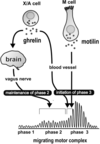Random Flashcards
Draw a muscle cross-section

Stomach cross-section

Explain what amino acids can be made into

Explain pacemakers in Cajal cells in GI

Explain the cholesterol pathway in the liver

Explain Latch bridge cycling

Explain the layers in the GI gut

Explain the layers in GI (in detail cells e.g. in intestines)

Draw and label the cross-section of a liver lobule

Draw and label a smooth muscle

Explain the different types of muscles (simple)

Explain how peristalsis takes place

Label & draw the arteries of the eye
From the internal carotid artery

What is presbycusis? (causes & classification)

What are the different types of atrophy?

What is SMA?
Is autosomal RECESSIVE
- Primarily due to SMN1 mutations
-
4 Types
- 1 - onset at 6 months unable to sit down on their own die as child (most common)
- 2 - 6-18 months get symptoms live
- 3 - least severe able to walk etc
- 4 - in adulthood (non-lifethreatening), weakening of muscles
- Treatments are gene therapies - target splicing of genes making shortened truncated but functional protein

What is dorsiflexion & plantarflexion?

Layers in blood vessels arteries & veins

What are the names of prostaglandin inhibitors and agonists?
- -prost- = agonists
- -iprant = antagonists
What is made in the adrenal gland and where?

What are the effects of glucocorticoids?

What does pannus mean (RA)?
‘Pannus’ describes the hyperproliferative, inflammatory invasive vascularised tissue mass that is a hallmark feature of the joint in RA
What are the steps in RA?
Risks?
Characteristics
- Infiltration of synovium by inflammatory cells and proliferation of synovial cells
- Increase in blood vessel formation
- Increased chemokine production and upregulation of adhesion molecules expression on vascular endothelium
- Cytokine production initiates matrix metalloproteinases (MMPs) release leading to degradation of matrix
- Pannus formation
- A lot to do with genes e.g. HLA which is found on MHC gene
- Smoking
- Diet
- Infection
- Pollutants
Inflammation in RA is chronic through the persistent activity of immune/inflammatory cells and the abundance of mediators, they release
Also get fevers and systemic infections, pericarditis
What are the types of T helper cells and how are they made and what do they produce?










